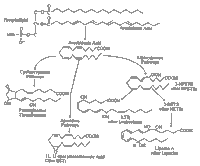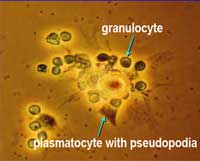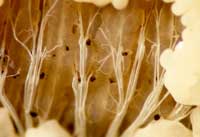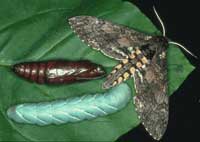- Department of Biological Sciences
- About Us
- Faculty
- Jon Miller
- Research Synopsis
Research Synopsis in the Miller Lab
The phenomenology of insect immunity is fairly well known. Because of their short life spans relative to most vertebrates and the diversity of their habitats, insects face unique immunological challenges. Insects also serve as vectors for human diseases such as malaria and trypanosomiasis. Therefore, knowledge of the insect immunology can yield information important in the prevention of human disease as well as insights to the study of immunology in general.
The term eicosanoid denotes a group of biologically active metabolites of certain C20 polyunsaturated fatty acids. These molecules play important roles in the physiology of vertebrates and invertebrates by acting as local, intracellular modulators of biochemical activity in cells. Dr. David Stanley recently discovered that prostaglandins and other eicosanoids mediate insect cellular immune responses to bacterial infections. This was a novel insight, then regarded as the first work on immunity signaling mechanisms in invertebrate animals. This original work opened widely the question of which specific cellular immune reactions might be mediated by eicosanoids. The quantitatively most important reaction to bacterial infections is known as nodule formation, a process that involves the direct capture of bacterial cells in a matrix of insect hemocytes. Nodule formation begins with formation of microaggregates, which grow by successive hemocyte adhesions into large nodules. Insects may invest literally millions of hemocytes into clearing bacterial infection from circulation. I have developed quantitative assays for microaggregation and nodule formation and used these assays to test the hypothesis that eicosanoids mediate these two cellular immune reactions.
Although this work received considerable attention, there remained some shortcomings. For example, all the initial research was conducted on a single insect species, the tobacco hornworm, Manduca sexta. Something close to a million insect species are known, and it is difficult to extrapolate findings from one species to all insects. This issue was addressed by broadening the experimental work to other insect species. Similar results on six insect species are now published. The idea that eicosanoids mediate insect microaggregation and nodulation responses to bacterial infections is now on much firmer ground. However the source of the mediating eicosanoids is still unclear.
The eicosanoids involved in mediating insect cellular immune reactions could originate in the hemocytes per se; however, there is no direct evidence on the point. Both fat body and hemocytes (the major insect immune tissues) from tobacco hornworms are competent to biosynthesize eicosanoids. Also, it has been reported that bacterial infections simulated increased hemolymph prostaglandin (and other eicosanoid) titers, but again, there is no evidence that the eicosanoids originated in circulating hemocytes. It is the focus of my lab to explore this biological question and to further investigate the many discrete steps of insect cellular immune reactions to bacterial challenge.
An overview of eicosanoid biosynthetic pathways, as understood from the mammalian background. Major families of eicosanoids include postaglandisn, epoxyeicosatrienoic acids and many lipoxygenase products.
Manduca sexta (tobacco hornworm)



